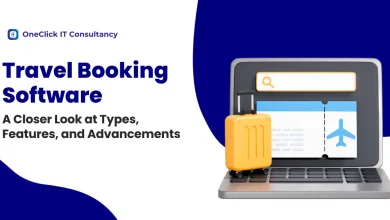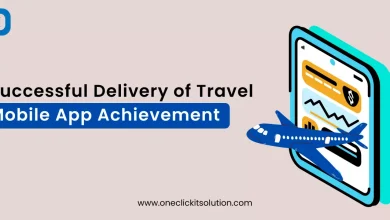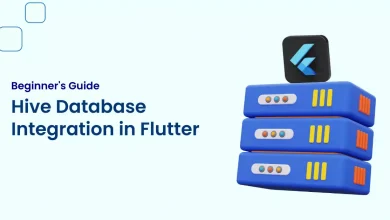Beginner Tips for Choosing the Right Tech Stack for Your Travel App
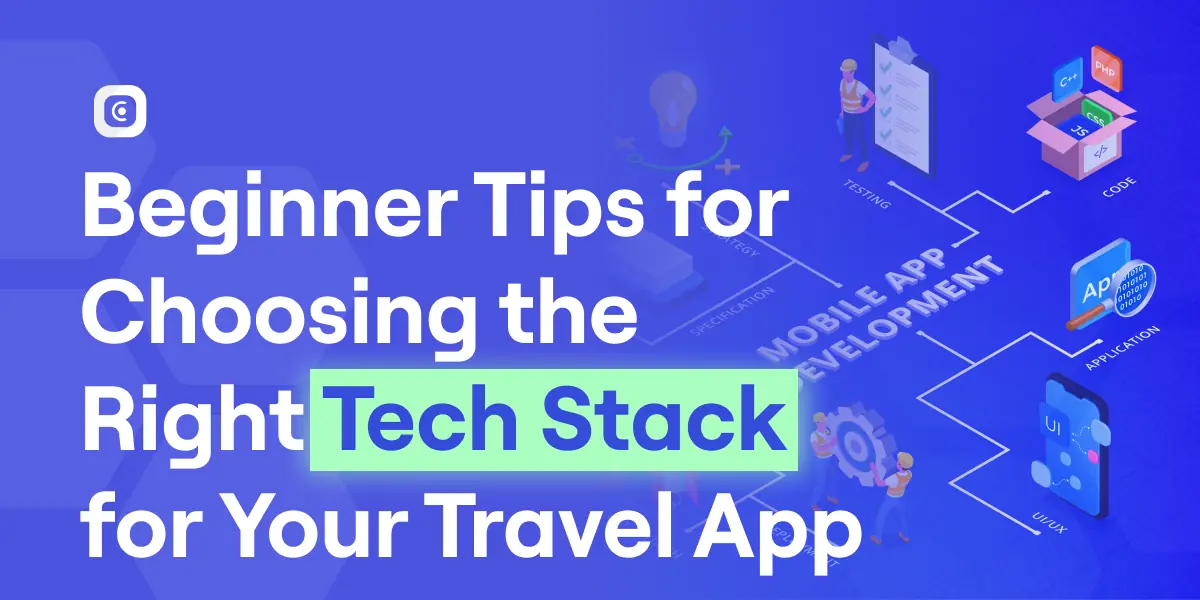
Even a novice in the world of mobile app development is aware of the tech stack concept. However, it’s not an easy decision as there’s no one-size-fits-all solution. An ideal and robust tech stack is what can help you create a travel app that stands out from the competition. To help you with the same, this guide will provide actionable beginner tips for choosing the right tech stack for your travel app.
In the fast-paced travel industry, building a travel app is more than just booking engines and fancy UIs. It starts with selecting the right technology stack, the foundation that determines performance, scalability, cost, and long-term success. Here we’re not just going to determine the definition of tech stack for mobile app development, but will meticulously cover the entire concept with proper guidance to help you build the perfect travel app.
What is a Tech Stack & Why Does It Matter in Travel App Development?
Let’s kick off our discussion by unraveling the true meaning of mobile app tech stack. A technology stack, or tech stack, is a combination of programming languages, frameworks, libraries, tools, and software used to build an application. It includes both front-end and back-end technologies.
Components of a Tech Stack
Here are the components essential for an efficient and smart tech stack for travel mobile app development. The complete technology stack for mobile application development can be categorized into five areas. These are the areas that constitute the analysis of an application.
The table compares all the layers with definitions and prime examples briefly:
| Layer | Description | Examples |
| Front-End | Role in user experience and interface design | HTML5, CSS3, JavaScript, React |
| Back-End | Server-side logic, Travel API integration, and authentication | Node.js, Python, PHP, Java |
| Database | Stores user and system data | MySQL, MongoDB, PostgreSQL |
| Server | Hosts your application | Apache, Nginx, AWS EC2 |
| Operating System | Manages server and hardware resources | Linux, Windows Server |
Web vs. Mobile App Tech Stack: What’s the Difference?
Now, for those who have just begun their app development tech stack journey, here’s a quick difference between the popular formats. Refer to the table below for a brief idea of the differentiation between the two:
| Factor | Web Application | Mobile Application |
| Platform | Browser-based | Android/iOS/Hybrid |
| UI Technologies | HTML, CSS, JavaScript | Swift, Kotlin, React Native, Flutter |
| Backend | Common for both | Can vary if offline-first mobile apps |
| Performance Tuning | Web-optimized | Hardware-level performance optimization |

Most Popular Tech Stacks for Mobile Travel App Development
Let’s now uncover some of the most popular and suitable mobile tech stack options that can help you bring your ideas to life with maximum efficiency.
Native App Stack
A native app stack is defined as the set of software, libraries, and tools that are used for developing native apps (for iOS or Android) using the operating system’s native language and APIs. It gives amazing access and performance from the platform features. Swift and UIKit are a part of the stack on iOS, while Kotlin and Android SDK are used on Android.
Key Components of a Native App Stack are as follows:
- Language: Swift (iOS), Kotlin/Java (Android).
- Frameworks: UIKit (iOS), Android SDK (Android).
- Libraries: Various libraries for tasks like UI elements, data handling, networking, etc., specific to each platform.
- Tools: IDEs (IntelliJ, Xcode), build tools (Gradle, Xcode build system), and testing tools.
- Platform-Specific APIs: Access to hardware and system functionalities (camera, GPS, etc.) through platform-specific APIs.
Cross-Platform App Stack
A cross-platform app stack is a software stack that allows a developer to create an application that can run natively on different operating systems from a single code base. Examples include Android and iOS.
The purpose of these stacks is to reduce development time as well as costs through code reuse.
Look at the key components and frameworks of a Cross Platform App Stack because they help build cross platform applications.
- React Native: It uses JavaScript and React, a JavaScript library for building user interfaces and creating mobile apps.
- Flutter: Developed by Google, Flutter uses Dart, a language for creating UI elements, and is known for its fast development and visual appeal.
- Xamarin: A Microsoft framework that allows developers to write native-looking applications for Android and iOS using C#.
- Ionic: Uses open-source web technologies like HTML, CSS, and JavaScript to build cross-platform apps with a native-like feel.
- NativeScript: Enables building apps using JavaScript, TypeScript, or Angular, and uses Native SDKs for platform-specific features.
Progressive Web Apps (PWA)
A Progressive Web App (PWA) is really just a web application that is providing of a native app-like experience for the users that it uses of modern web capabilities. It readily becomes accessible because individual users discover the platform whenever they search.
PWAs feature a variety of capabilities that bridge customary websites as well as native apps. Users can install them onto devices, and they can access push notifications with offline access.
The key characteristics of PWAs are listed below:
- Responsive
- Installable
- Reliable
- Modern APIs
- Single Codebase
- Discoverable
Essential Factors to Consider Before Choosing a Tech Stack
Before choosing a tech stack for mobile app development, here are a few factors to consider for the best results. Additionally, refer to the infographic provided below for a better understanding of the workflow driven by the app tech stack.
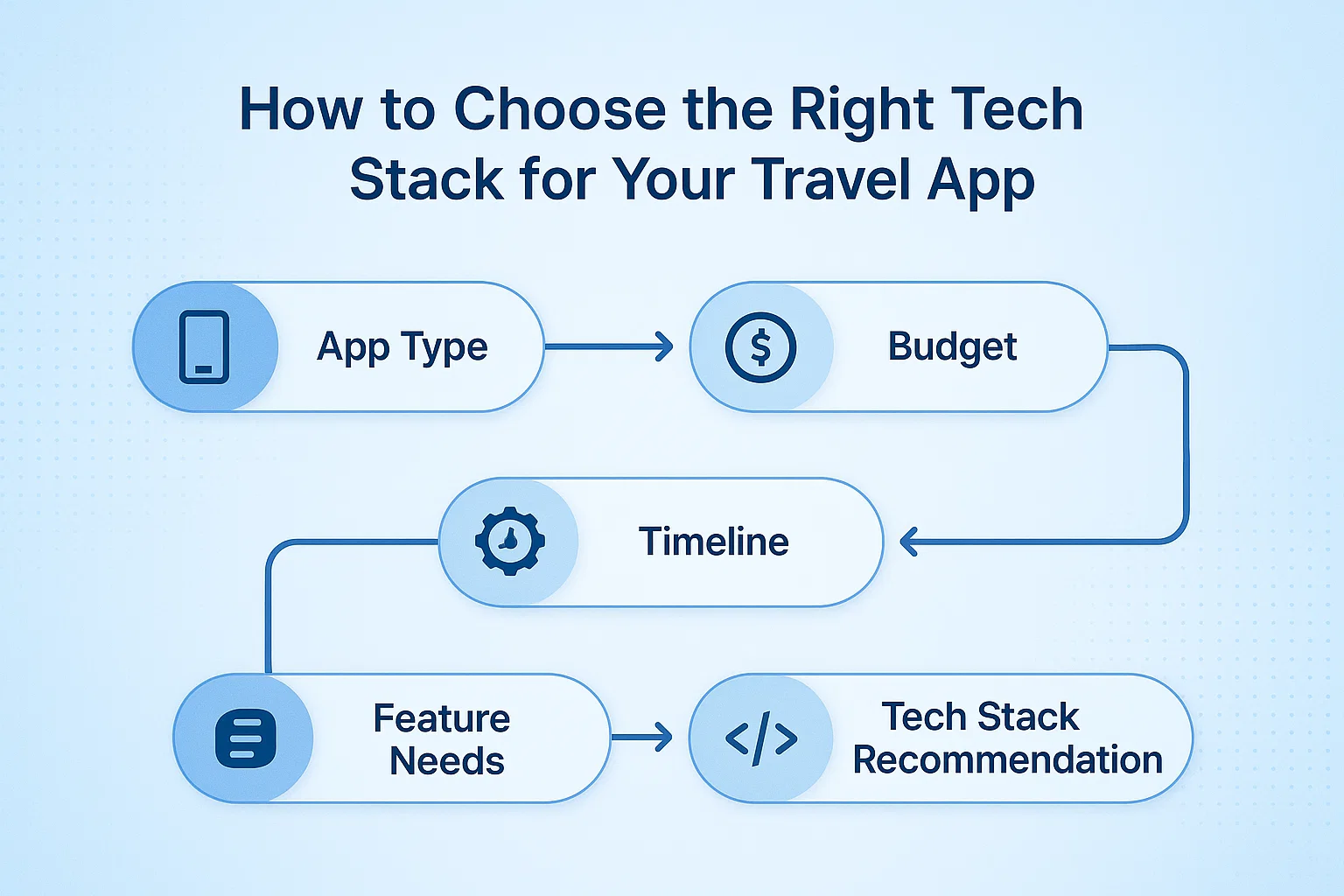
If you’re also wondering how to choose a tech stack for developing a travel app, then here’s a checklist that will help you indefinitely.
App Complexity & Features
Target those attributes in the tech stack that you seek. This is an important step which will help you to define the mobile app development process for you. You will also opt for a tech stack according to customer requirements. Through a focus on features such as multilingual support, geolocation, itinerary management, etc, you are able to allow for easy user access as well as greatly satisfy such users.
Time-to-Market & Budget
For the OTAs, tour operators, travel agencies, and businesses, it’s crucial to equip themselves with a tech stack that helps in reducing the time-to-market without affecting the budget. This especially helps the travel companies that provide seasonal apps with dedicated services and discounts. Another alternative to this problem is to opt for white-label travel portal solutions that are just ready to go.
Security & Compliance
Given the advancements in technology, security also improves as we experience with them. Choosing a technology stack to keep those risks at bay is indeed important. So many data leaks as well as phishing attacks are indeed on the rise. Adhering to a number of industry regulations like CCPA, GDPR, and PCI-DSS ensures that the finalized tech stack provides secure payment gateways for customer transactions.
Scalability for High Travel Seasons
To ensure your travel app can handle increased traffic during peak travel seasons, focus on a scalable backend that can adapt to high demand. Implement features like load balancing, caching, and database optimization to prevent downtime and maintain user experience. The best way to streamline this factor is by going after mobile app tech stacks that provide cloud integration, like AWS and Azure.
In-House vs Outsourced Development Team
For businesses with a big operation that can afford a team of skilled developers, it’s better to go for in-house development as it will provide you with complete control over the process. On the other hand, if you do not have access to such a varied team, there are always outsourced app tech stack mobile app development options that can provide all the resources and help you need to build a travel app.
Travel App-Specific Requirements That Influence Tech Stack Choice
To build the perfect travel app, the influence of tech is simply not enough. There must be a proper balance of all the necessary features that help you stand out from the current competition.
Integration with GDS, OTA, and CRM Systems
Enrich your travel application for mobile with popular GDSs like Travelport, Amadeus, or Sabre. This API integration will help you provide real-time updates for modules like flights, hotels, car rentals, and much more.
Additionally, you can also improve the user experience by integrating geographic, chatbot assistant, and weather alert support.
Multilingual and Multi-Currency Support
Dedicated support with features such as multilingual support that is enabling of the users to access the portal in their preferred language should be provided in order to cater to the international customers. Additionally, multi-currency support allows the global travellers are able to make payments with such ease via cards, wallets, as well as net banking, and even much more.
Offline Capabilities
Offline features make a travel application the best of all. If your customers could access their custom itineraries without any internet connection, it would enhance the user experience significantly. By focusing on such small features that can improve the user experience, you can seamlessly improve the customer satisfaction rate.

Tech Stack Comparison Table – Which One Fits Your Travel App Needs?
Refer to the table below to find out the best suitable tech stack that fits your travel needs and is perfect for your future goals.
| Criteria | Native | Cross-Platform | Hybrid | PWA |
| Performance | Excellent | Good | Moderate | Moderate |
| Development Speed | Slow | Fast | Fast | Very Fast |
| User Experience | Best | Great | Average | Web-like |
| Maintenance | Complex | Simple | Moderate | Simple |
| Cost Efficiency | Low | High | Medium | High |
How OneClick Can Help You Build the Perfect Travel App Stack
Below are some of the capabilities you can get access to by partnering up with OneClick:
- Custom Consulting: Helps by recommending the latest trends and scalability needs to create a tailored app that aligns the tech stack with your business goals.
- Rapid Prototyping: Quick turnaround for MVPs (Minimum Viable Products), further backed by early validation of app ideas with low investment.
- GDS/API Integration Expertise: Enhance your travel app with Amadeus, Sabre, Travelport, and others through seamless integration with third-party services, including flight booking, hotel reservations, and payment gateways.
- Cross-Platform Development Skills: OneClick can seamlessly help you build apps that run smoothly on iOS, Android, and the web.
- Security Compliance: We ensure PCI-DSS, GDPR, CCPA, and travel industry-specific security standards to protect your company and customer data at all times.
- Scalability Planning: Scale your travel app on-demand with our tech stacks designed to grow with your business. Additionally, get 24/7 customer support to address all your needs.

Ready to Jet-Set Your Travel App with the Perfect Stack?
Choosing the right tech stack isn’t just a technical decision, it’s a business strategy. Build wisely, scale effortlessly, and delight users consistently. And if you feel stuck in any step of the process, OneClick experts are always there to assist you in the journey with promised success.
FAQs
Yes, but it’s often costly and time-consuming. To avoid this occurrence, always build a travel app with a modular architecture, as it eases transitions.
Low-code or no-code options like white-label travel app solutions fits well for small businesses and OTAs. However, to build a scalable and secure solution, it’s better to choose custom development.
By adopting the latest technologies, prioritizing scalability, and keeping community support in mind, travel companies can prepare their solution for future challenges.
If personalization or recommendation engines are a core feature, then yes, as it influences backend and data handling tech.


